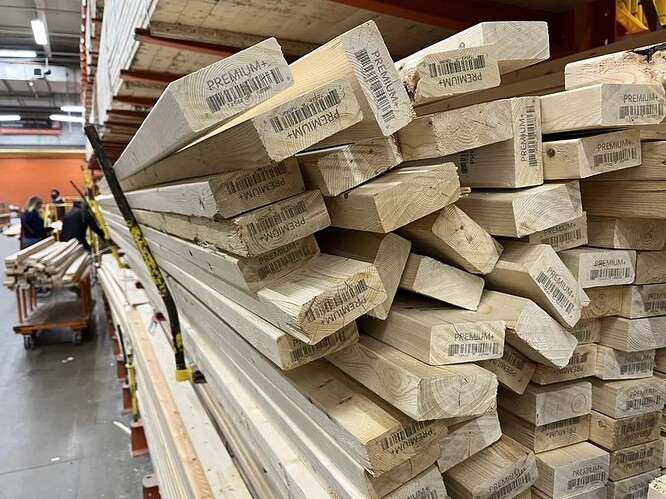U.S. builders pay a premium for the spruce, pine and fir (SPF) lumber that B.C. produces and could soon face additional tariffs after President Donald Trump’s proclamation that America doesn’t need the province’s wood.
They like it, particularly for framing walls because SPF is lighter, stronger and tighter-grained than the more abundant southern yellow pine lumber that is common in America and has a reputation for warping.
U.S. builders also need it since, despite Trump’s declaration that “we have more lumber than they do,” American mills still don’t make enough lumber to fill U.S needs.
“There’s just this gap between what the U.S. can supply and what their demand is,” said Kurt Niquidet, president of the B.C. Lumber Trade Council, the main trade group that represents the B.C. industry’s interests in the U.S.-Canada tariff dispute.
Since 2017, B.C.’s lumber producers have faced countervailing and anti-dumping duties on U.S. shipments. Over the last year those have ranged from 11.5 to 16.6 per cent on $3.5 billion of B.C. lumber exports. Companies are now bracing for Trump’s on-again-off-again threats of an additional 25 per cent tariff on exports on all Canadian goods to stick as of April 2.
The U.S. National Association of Home Builders estimated that tariffs on all materials would increase the cost on new homes to US$9,200 per unit.
“It’s frustrating, but I think the facts of the matter point to something different,” Niquidet said.
What is Canada’s share of U.S. market?
The U.S.’s housing market consumes a massive amount of lumber, some 50 billion board feet in 2024, but its lumber producers could only supply some 35 billion board feet, according to longtime industry consultant Russ Taylor.
“There’s no way American supply, in the short-term, can do anything but rely on Canadian lumber,” Taylor said.
As of 2024, Canada made up about 12 billion board feet of the U.S. shortfall, 24 per cent. B.C. makes up more than half of that. The U.S. gets another six per cent of its lumber from overseas, mainly from Europe.
“Tariffs are just going to push the price up and create shortages,” Taylor said. “It’s just going to be market chaos, as it will be with (oriented strand board panels) as it will be with pulp and newsprint.”
Why do builders like Canadian lumber?
Spruce pine and fir lumber isn’t exclusive to Canada but it’s what mills in Canada’s boreal forests produce and is “a differentiated product” in the housing market, according to Niquidet.
“People like it for framing homes and so on,” Niquidet said. “They like that it’s strong and it doesn’t warp and twist, so it’s got a good reputation with homebuilders.”
For those reasons, Niquidet said there will likely still be demand for Canadian lumber even if the U.S. was able to expand its own lumber production as Trump has said he wants to.
“What’s happening in the market right now, there’s actually a large premium on SPF over southern yellow pine,” Niquidet said.
Niquidet said that, recently, U.S. buyers were paying US$547 for 1,000 board feet of two-by-fours, the standard measure, compared with just over US$400 for southern yellow pine.
Can U.S. expand production?
Trump, on March 1, signed an executive order aimed at the “immediate expansion of American timber production,” intended to pare back what are characterized as “heavy-handed federal policies,” restricting the availability of timber on U.S. federal lands for lumber production.
Trump, in his order, stated the U.S. “has an abundance of timber resources that are more than adequate to meet our domestic timber production needs,” but tapping that wouldn’t be a short-term project, according to Taylor.
Lumber producers would have to build the infrastructure needed — roads, bridges and transportation nodes — to start logging with big questions over where the labour to do so is going to come from, Taylor said.
New sawmills, he added, are major capital investments that cost roughly US$300 million to construct, and “who’d be going to build a mill not knowing what the rules of the game are? Are tariffs on or off, for how long?”
What are consequences of tariffs?
The irony of tariff threats is that they’re hitting the B.C. industry at the same time that it’s suffering through rounds of mill closures, consolidations and reduced production.
B.C.’s exports to the U.S. in 2024, some 10.4 million cubic metres of lumber, were down one per cent from 2023 and 42 per cent from the industry’s last peak in production in 2016 when the province exported 17.9 million cubic metres of lumber.
The province’s biggest lumber companies such as Canfor, West Fraser Timber Co. Ltd., and Tolko, have already made major investments in the U.S. South.
“If we do see the 25 per cent go ahead on April 2, that would push us up to 39 per cent combined tariffs,” Niquidet said. “So we expect the affects both sides of the border.”
Niquidet said Canadian producers would be able to pass on some of the increased cost to its buyers, but we’ll likely see some of B.C.’s higher-cost mills cut back on production or even close.
B.C.’s industry is also bracing for an increase in tariffs under the existing softwood lumber dispute. In February, the U.S. Department of Commerce made a preliminary recalculation of those duties that would increase them from 10 to 34 per cent.
So those duties, combined with Trump’s tariffs, would raise the export bill to 55 per cent.
